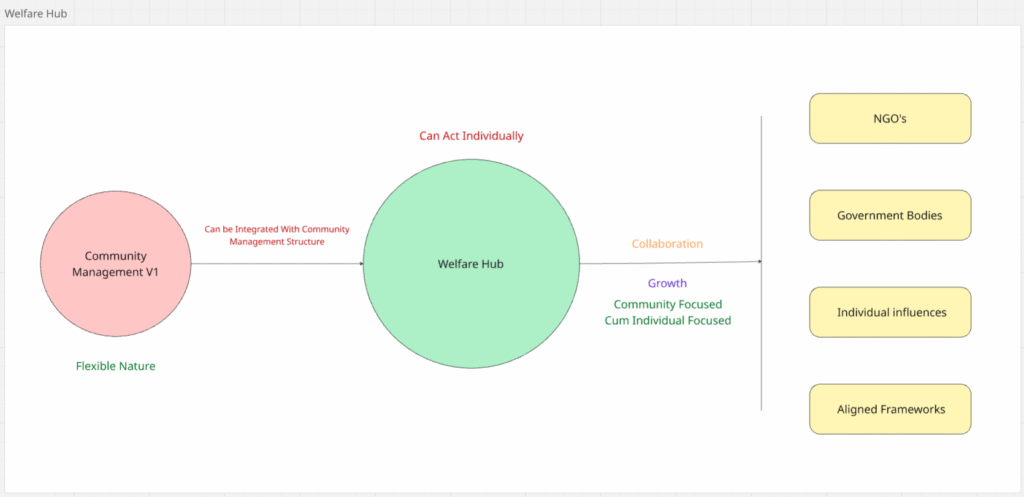The whole system here is about to be designed to be adaptive and community-centered, allowing for customization and flexibility in each pillar—governance, welfare, leadership, resource management—based on the unique needs and goals of the targeted community.

Custom Planning for Communities
Every community has different requirements, challenges, and aspirations. The system allows each pillar (leadership structure, rules, operational plans, engagement methods) to be tailored to best serve the specific demographics and context of the community involved.
This flexibility ensures maximum effectiveness and relevance.
The Resident / People Welfare Hub
The Welfare Hub operates both as a central system within the broader community structure and as an autonomous platform for supporting individuals.
Its main purpose is to foster awareness, personal growth, and collective empowerment among the members of the community.
The Welfare Hub is also the key conduit for collaboration—with NGOs, government agencies, activists, and other stakeholders—focusing on holistic community development and individual upliftment.
Collaboration and Independent Action
Through the Welfare Hub, partnerships are established with various external organizations to leverage expertise, resources, and support for the community.
Simultaneously, the Welfare Hub functions as a support system for individuals, enabling targeted interventions for personal advancement and well-being.
This dual approach ensures that community-wide progress and individual growth go hand in hand, leading to more sustainable and impactful outcomes.
In summary, the system’s strength lies in its adaptability—allowing for dynamic planning and integration of the Welfare Hub, which links community management with individual development through strategic collaborations. That’s correct. The system here describe is fundamentally built to be flexible—a custom planning framework, where every pillar (leadership, rules, operational plan, resource management) can be tailored to suit the unique realities and priorities of the targeted community.
Community-Centric Customization
Each community segment can have distinct rules, leadership models, operational methods, and engagement protocols.
This adaptability allows the system to be maximally relevant, effective, and sustainable for the group involved.
Role of the Welfare Hub
The people Welfare Hub acts as both a catalyst and a bridge, focusing primarily on community-wide awareness and holistic people development.
It can integrate with the larger governance structure or stand independently to focus on the growth and needs of individuals—for instance, skills development, education, or social support.
Collaboration and Growth
The Welfare Hub becomes the center for all partnerships—with NGOs, government departments, activists, and aligned organizations.
Its purpose is to coordinate resources and expertise, amplifying both individual empowerment and collective progress.
This model positions the hub as a proactive, collaborative system committed to maximizing well-being and opportunity for every member.
In essence, this approach enables communities to continuously upgrade and calibrate their systems, ensuring both collective welfare and individual advancement are always front and center. Yes, this approach recognizes that effective systems must be adapted to fit the needs and culture of each specific community. Every pillar—from leadership style to rules and operational plans—can be customized to best serve the people involved.
The Resident/People Welfare Hub operates both as a part of this customized system and independently as a standalone support mechanism. Its primary mission is to promote awareness and growth at both the individual and community level.
Within the Welfare Hub, collaboration with NGOs, government agencies, individual activists, and other supportive organizations creates a network for comprehensive growth and support. This not only addresses the community’s collective needs but also empowers individuals through partnerships and targeted initiatives.

Leave a Reply